
Thank you for visiting HOJO website. If you have any enquiry, please feel free to get in touch with us at
▼ Akira Hojo
▼ Hojo Newsletter
▼ HOJO FACEBOOK





HOME > Oolong Tea > Phoenix Oolong
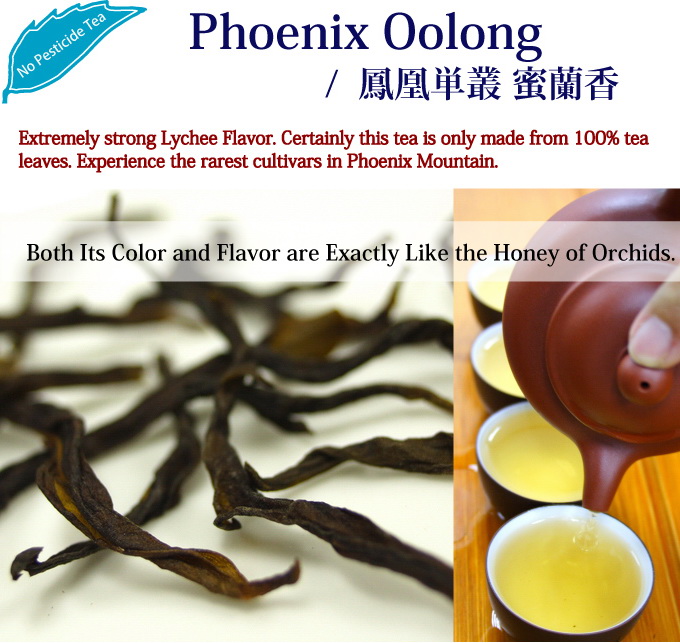

Phoenix Oolong is a historically reputed tea in China since the Ming Dynasty. The name originates from the birth place of this oolong tea: the Phoenix Mountain (凤凰山 Feng-huang Shan). It is located at the Phoenix Town at Chao-an County (潮安县 Chao-an Xian) at Chao-zhou City (潮州市), Guangdong Province (广东省).
Phoenix Mountain is famous of its rich resources of tea cultivars. Up to date, there are more than 80 cultivars. Each cultivar can grow up to a few meters height and produces tea with a distinctive flavor profile. Therefore, every single shrub is harvested and processed individually, that's where the name Dan-cong (单丛) is being derived. The name Milan Xiang is given based on its honey-like with flowery note aroma.
To produce the unique Phoenix Oolong, every single twig of tea leaves is plucked from a single shrub of tea tree. Much intensive manual work has to be carried out during the fermentation process (called 做青) in order to strictly control the degree of fermentation: the leaf is damaged only at the edges, which will oxidize while the middle part of the leaf remains intact, preserving the natural green fresh note.
Conventionally, the brewing of Phoenix Oolong is named as Gongfu Cha (工夫茶). This is because of the time, effort and skill spent during the making of tea. In addition, it is referring to the tedious selection of material and way of brewing. HOJO particularly focuses on Phoenix Oolong tea which is named as Milan-xiang Dan-cong. In addition, we choose non-pesticide tea as our stringent standard of selecting tea products.
The Phoenix tea has had a long history behind it. It was said that during South-Song Dynasty (南宋 Nan-Song), the Emperor went to Chao-shan (潮汕) and passed-by the Phoenix Mountain. He felt thirsty, and his servant plucked the leaves from tea tree and prepared the drink to serve. It quenched his thirst at once and he was very happy. Due to its shape of leaf which is similar to the beak of a bird, it was named "Beak Tea" (鸟嘴茶 Niao-zui Cha). Since then, it was widely planted. It was also named as Song Cultivar (宋种 Song-zhong) because it was planted since Song Dynasty. Up to date, the cultivar has lasted for more than 900 years. Since Ming Dynasty (明代 Ming-dai), it became the tribute tea to emperors.
The Phoenix tea originates from Ku-zhu-keng Village (苦竹坑村) at Phoenix Town (凤凰镇 Feng-huang Zhen), located at the northern area of Chao-zhou City (潮州市) at Guangdong Province. The mountain is 1498 m a.s.l., it is the highest peak at Chao-zhou City. This area is located at the southern Asia tropical climate zone. There are plenty of waterfalls found at this areas; this area is cloudy with heavy dew. The atmosphere with relatively high humidity and sufficient rainfall is favored to the growing of tea trees.
Besides, at high elevations, there is a significant temperature difference between day time and night time. During the day time, there is sufficient sun light and tea leaves vigorously produce plentiful of substances such as amino acid and carbohydrate, which are essential for the production of exclusive quality tea as well as the growth of tea leaves. At night, if the temperature is high, the metabolism will continually take place, and tea leaves will consume the substances that were produced during the day time. However, at the high elevations such as at mountainous areas, the lower atmospheric temperature at night caused the tea leaves to become less active and therefore those substances remain in the leaves.
With these factors, tea leaves are very rich in substances that contribute to the quality of tea.
The name of 凤凰单丛 means the single shrub (单丛 Dan-cong) of tea cultivar. This is referring to the individual plant selected and cultivated from the group of Phoenix Shui-xian tea cultivars (凤凰水仙群体品种 Feng-huang Shui-xian Qun-ti Pin-zhong) found at the Phoenix Mountain (凤凰山Feng-huang Shan). There are many sub-cultivars under the group of Phoenix Shui-xian cultivars, and each individual shrub has its own characteristic in terms of the leaf and shape of tea tree. The made tea will give a wide range of aromatic profile which varies among different individual shrub. The name of 蜜兰香单丛 (Milanxiang Dan-cong) is given with referring to the fragrance of finished tea: the honey-like flavor with orchid fragrance. The mother plant of the cultivar is aged more than 200 years. This selected individual plant is particularly bred and processed. This is one of the remarkable cultivars among the Phoenix cultivars.
This cultivar is the small arbor (小乔木 Xiao-qiao-mu) with leaf of middle size in long-oval shape. The leaf is yellowish green in color with a sharp tip. The leaf is very thick but soft with bud in light yellowish green color. The budding season starts by the end of March.
The GC/MS analysis result showed that this cultivar contains more than 50 kinds of aromatic substances, including 1) linalool, the naturally-occurring substance which gives pleasant floral scent, 2) farnesol that gives sweet floral fragrant, 3) geraniol that gives rose-like odor, and many others substances.
The plucking starts by the end of March. When the first buds grow and fully develop, it is called Zhu-ya (驻芽). This indicates the starting of plucking season: the bud is plucked together with 2-3 leaves. The plucking is carried out during sunny day in the afternoon, around 2-4pm. In particular, the plucking is not carried out if leaf is covered with thick dew or after the rain. The hand-plucking is carried out with care in order not to cause damage to the leaf, and the plucked leaf must be lightly placed in the bamboo basket.
After plucking, the leaves are brought back to the factory, and then spread to the thickness of about 10 cm on a bamboo mat. After that, the bamboo mat is transferred outdoors and leaves are withered under the sunlight, at 4-5 pm. The leaves are then thinly spread to about 3 cm and should not overlap. In general, withering is carried out when the atmospheric temperature is < 35℃. The leaf is withered for different periods of time, depending on the atmospheric temperature: 1) 15-20 minutes at 22-28℃, 2) 20-30 minutes when temperature is about 20-25℃, 3) about 10 minutes if the temperature reaches 28-33℃. The actual time of withering is also affected by the water content of leaf. During withering, the leaf is not turned over as not to cause damage to leaf. The withering is sufficient when: 1) the bud bends down 2) leaf become softer and omits its fresh green note, 3) the color of leaf changes from fresh and luster green to a dull and darker color. The leaf has lost about 10-15% of its moisture.
After withering under the sunlight, the leaf is transferred to a shady and cool place indoors and allowed to cool down for 1-2 hours. The purpose is to enable further withering under cooler conditions. The sun-withered leaves are gathered, and the thickness of the spread out leaves is adjusted according to the atmospheric condition: during the windy season, the thickness is increased to prevent excessive lost of moisture from leaf.
During this period, the biochemistry reaction takes place at a slower rate. It increases the by-product of hydrolysis process in leaf, and enhances the permeability of cell wall, and increases enzyme activity, e.g. polyphenol oxidase (PPO).
This process is also called碰青 (Peng-qing), or 浪茶 (Lang-cha). This is the most critical process in making Phoenix tea. It is manually carried out to cause damage to the edges of leaves, and destruct the cell walls. The enzyme polyphenol oxidase reacts with the substrate and forms the substances which contribute to the flavor, taste and color of tea. The atmospheric condition required for the oxidation is with temperature at around 22-28℃, and relative humidity about 75-85%. The process starts in the evening at 6 - 7 p.m., and continues for 10-12 hours until the next morning.
In most cases, a bamboo plate is used. The diameter is 130cm, the depth about 28cm and the size of opening is 0.5cm x 0.5cm. The bamboo plate is hung in the room. In every bamboo plate, 5-6 kg of leaf is placed. Two workers will stand at opposite directions, holding the bamboo plate and shake it upwards and downwards for 15 times. In the plate, the leaves move in a wavy style. After this, leaves are gathered and placed on bamboo pan, formed the 凹-shape, and left for 2 hours until the next process 碰青. For the second and third time of process 碰青, the same procedure in the bamboo plate is repeated for 30 times and 45 times, respectively. After each step of process 碰青, the leaves are left for 2 hours. For the 4th, 5th, and 6th times of process 碰青 (or sometimes up to 7th times), the leaves are placed in the bamboo drum: with a length 200 cm, inlet 75cm, and the size of opening at 0.6cm x 0.6cm. About 25-30kg of leaf is placed inside the drum. The rotation of drum is carried out at different periods of time: 5 minutes for the 4th times, left for 2.5 hours, then rotated for 10 minutes during the 5th times, left for 2.5 hours, and at 6th times, it is rotated for 20 minutes and left for 1-2 hours.
The inspection of the degree of oxidation is mainly based on the changes of flavor, and the shape and color of leaf. During the process, the leaf emits its fresh green note during the 1st and 2nd stage, and no grassy flavor is detected. When the process is repeated for the 3rd and 4th times, the fresh green note become stronger with mild sweet sugary flavor. After the 5th and 6th times of oxidation, the fresh green note become less while the fruity and flowery flavor is stronger. The indication of sufficient oxidation process is:
At this moment, the moisture content of leaf is about 68%. The leaf is then gathered together, and left for an hour before it is pan-fried.
During the pan-frying process, the high temperature and short time of heat treatment will inactive the enzyme instantly and prevent prolonged oxidation, stabilize the quality and characteristic of fermented tea leaves. The frying and rolling is carried out in turns, repeated twice to form the shape. During the first stage, when the pan temperature reaches 140 - 160℃, 1-2 kg of leaves are placed into the pan and fried for 4-5 minutes then removed from the pan. While the fried tea leaves remain hot, it is rolled by hand (sometimes a rolling machine is used). The tea leaf is rolled continuously and then the lump formed is separated. When the leaf has formed the primary strip-shape, it is placed back into the pan which is heated up to 100 - 120℃ and fried for another 3-4 minutes. Gradually, the leaves are heated, and become soft and slightly sticky, and can form a ball when grasped. When the leaves give off the greenish and grassy smell, and further emits the aromatic fragrance, this indicates that the frying is sufficient. At this moment, the leaves have lost their moisture content of 20-30%. The softened leaves are rolled until they form the tight strips with 40-50% of cell destruction. The tea fluid is squeezed and remains on the leaf surface and gives the luster appearance to the leaves. The expression of the juice over the leaf particles increases the strength of tea when brewed.
The tea leaves are dried in the bamboo basket (烘笼 Hong-long) that is heated using charcoal. The drying is carried out at two stages:
Leaf is thick, robust, naturally rolled, straight, and weighty.
Leaf in yellowish brown in color, it looks lustrous and glossy, with reddish spot on leaf. If poor quality, the leaf shows a dark and dull brownish color.
Dry leaves give a very strong fruity flavor like dried mango with flowery note. When brewed, the liquor gives the same aromatic profile. For real Phoenix Oolong, after brewing, the dried mango flavor still remains in the brewed leaf. The aroma is long-lasting, and can remains up to 6-7 brewing; the fruity aroma gets thinner after brewing for several times. If tea is of poor quality, the aroma of leaves can hardly be sensed after subsequent brewing.
When brewed, the tea produces a very bright, lustrous and clear liquor, in yellowish orange color. For poor quality, the liquor is a dull brownish color.
Thick and mellow, and taste lingers on the tongue and mouth giving a refreshing note, followed by a very strong sweet after taste. For poor quality tea, the taste is thin and flat, lack of sweet after taste.
The edges of brewed leaves are bright red in color and the middle part of the leaves are bright yellowish green in color. When touched with finger, the leaves are thick and elastic. If the tea is of poor quality, leaves are in dark color with a dull appearance and lack of brightness. When touched, the leaves are very stiff, with very thick and coarse leaf veins, and a lot of damaged leaves are found with broken edge.
Go to further information about suitable water for brewing tea >>
Many customers are afraid of brewing oolong tea as it seems very difficult. However it is not that difficult once you understand the theory.
At first, bring the cool water to boil. Use soft water for preparation of tea. The water processed by distillation or reversed osmosis is not suitable for brewing tea. These water contains no minerals and it will cause the tea to become tasteless. If normal tap water is used, it is advisable to use a filter. Boil the water just before brewing tea. It is very important to boil water so as to evaporate the chlorine and other types of contaminated substance in the water. Do not continue boiling for more than a few minuets as it will rather concentrate the mineral and the character of water may be converted to hard water.
The important point for brewing oolong tea is:
1) Use boiling water. 2) Avoid drastic decrease of water temperature. The sweet taste of green tea comes from the substance called amino acid which can dissolve in the water at a lower temperature. Therefore, low temperature is applied only for green tea. On the contrary, the taste of oolong tea comes from poly phenol and its oxidized substances. Those substances could only dissolve in the water at high temperature. In other word, you could not enjoy the real taste of oolong tea if it is brewed at a lower temperature. The taste of oolong tea very much depends on the brewing method.
In order to enjoy oolong tea, always ensure that the water temperature is very hot. Use boiling water and rinse tea pot with boiling water to keep it hot.
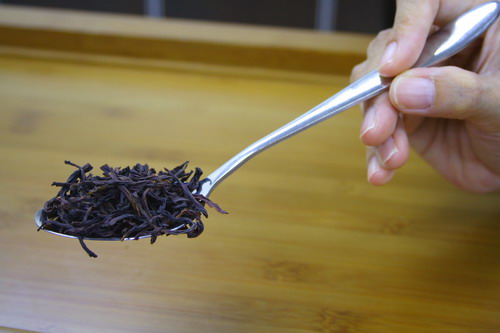
Usually 1g is equivalent to 25〜50ml of water. For the standard tea pot of 150〜250ml , about 5-6g of tea leaves is sufficient, and this can be measured by 2 table spoons.
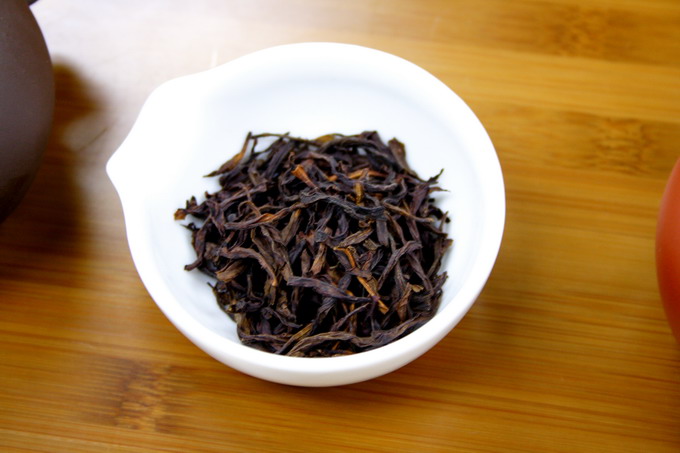
This photo shows the inspection plate which is convenient for placing the tea leaves.

It is suitable to use a red clay teapot. It has a heat retention characteristic and can maintain the tea at high temperature during brewing. This is vital to extract the substances from leaves.

Pour boiling water into the tea pot and fill up to 70%. This is to heat up the tea pot.
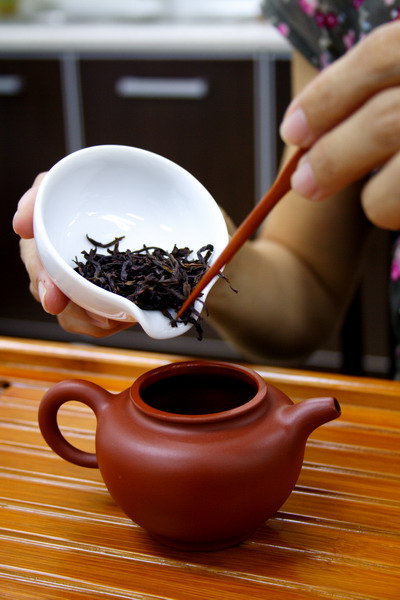
The tea pot in the photo is about 200ml and therefore we take tea leaf around 5g. Use a lesser quantity of the tea if a lighter taste is preferred. It is important not to touch the tea leaves in order to avoid the contamination of odor.
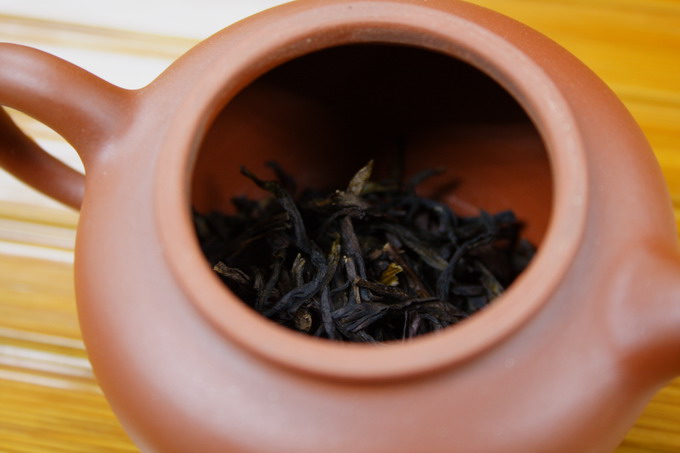
lace the tea leaves into the warmed tea pot. Tea leaves almost covers the bottom part of tea pot.
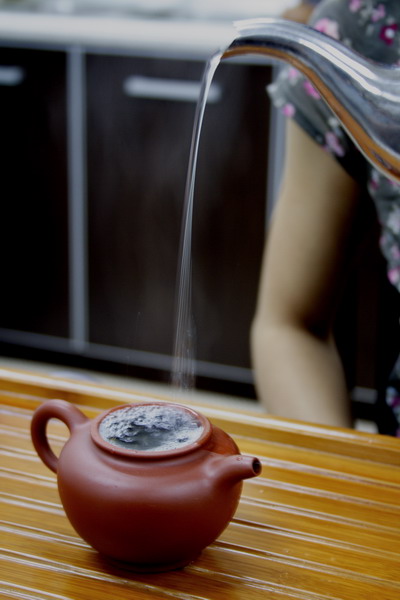
Pour in the boiling water gently and swiftly. Please avoid pouring from too high in order to avoid temperature drop.
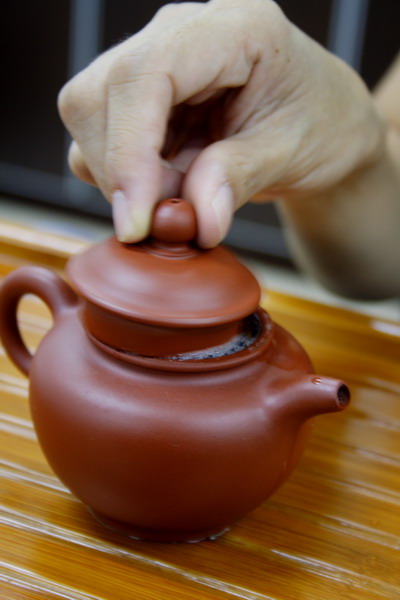
At first, please rinse tea leaf. It is to warm up the leaf. Rinsing must be taken place very short so as not to loose the taste from tea leaf. Usually I suggst less than a few second for rinsing.
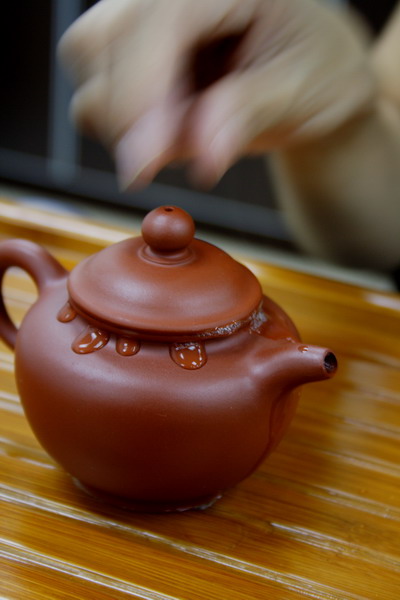
Brewing time is as follow.
1st: 20-30 seconds
2nd: 10 socond shorter
3rd: 20-30 seconds
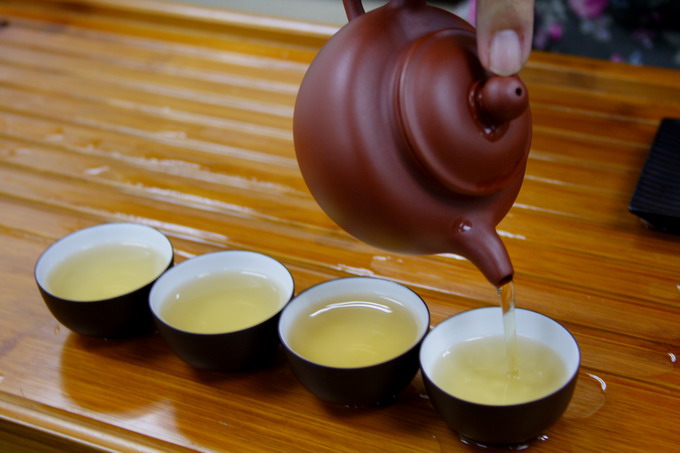
It is more advisable to use pitcher so as to even out the concentration of tea. Pouring tea directly into cup is not practical as usually small cup is used for oolong due to too high temperature.
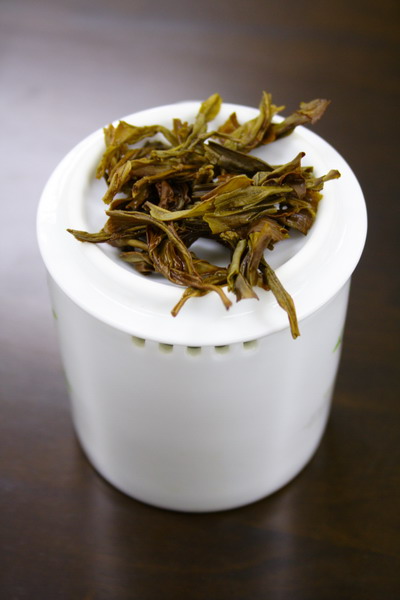
The leaves shown here lies on the professional inspection cup. If the tea leaves are of good quality, after cooling down, the brewed leaves still give a strong fragrance. The brewed tea leaves will indicate a lot more qualities of the tea than the in itself.
Avoid direct sun shine, high temperature and humid environment; store the tea in a well ventilated place. Phoenix Oolong will undergo further maturation if it is being kept in an ambient atmosphere. It will be more fragrant and sweet. Due to very low moisture content of tea leaves, it can easily absorb the odor from its storage environment. Therefore it is
The quality of tea lasts longer if it is kept in the fridge. However we strongly recommend you not to keep tea in the fridge. When tea is withdrawn from the fridge, there is usually condensation. Once tea is exposed to moisture during condensation, the quality will deteriorate within a few days. The higher moisture content in the tea leaves will trigger oxidation and it will completely destroy the quality of tea.
Here’s one frequently asked question: what happens if bag is sealed using tape or tea is packed in zipper bag and kept inside the fridge?
For your information, these simple sealing methods are not sufficient. When the bag is withdrawn from the fridge, it is cold inside the bag and therefore causes negative pressure. Air will be drawn from outside and condensation will occur. In addition, if the bag is taken in and out from the fridge very often, this will cause heat stress to the tea leaves as temperature is increased and decreased very frequently. If tea is kept in the fridge, when it is withdrawn from the fridge, it is necessary to leave it in ambient atmosphere for more than 24 hours in order to warm up the tea leaves. Based on our experience, 12 hours is not long enough. We may think tea is warmed up, but inside the bag, the tea leaves are still cold due to insulation effect.

 |
We accept various kinds of credit card through Paypal.
Only if customer prefer other option of payment, we suggest "Bank Transfer".
Various choice of shipping method
EMS, SAL, Small Packet, Small Packet (SAL) Yamato Express and Surface
For shipping tea, we usually suggest small air parcel, the estimated shipping cost of tea in 100g (with wrapping material ) is
Small Parcel
USA JPY 600, EU JPY600 and Asia JPY470
Small Packet (SAL)
USA JPY380, EU JPY380 and Asia JPY320
The shipping fee to oversea by small air parcel happens to be even cheaper than domestic shipping fee in Japan.
For your information, some countries, EU in particular imposes custom duty. We need buyer to bare the duty. We are sorry, but we cannot change the amount on the invoice, and we do not mark any packages as gifts. We will strictly follow the custom regulation.